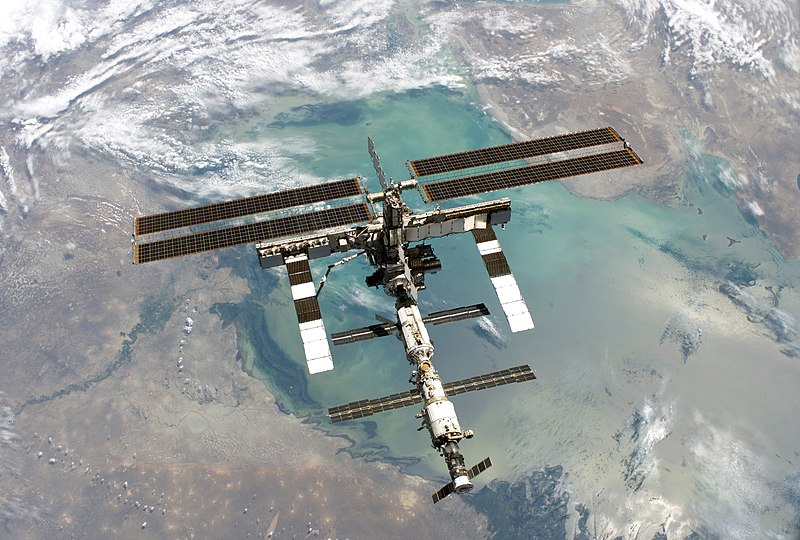 The ISS above the Caspian Sea. Photo credit: NASA
The ISS above the Caspian Sea. Photo credit: NASA
The Uncertain Fates of Satellites in the Russia-Ukraine War
Although Earth’s orbit is densely populated with Intelligence, Surveillance, Reconnaissance (ISR) assets that constitute extremely high-value targets, terrestrial wars have not yet extended their violence to space. The specter of fully-fledged space warfare still remains distant, but the Russia-Ukraine conflict is subtly eroding peace in Earth’s orbit. Specifically, Russia is setting a new precedent for wielding space as a diplomatic weapon. Ukraine’s dependence on Western commercial satellites creates intense targeting incentives for Russia with dangerous potential for escalation.
Space Hostages: Using Western Satellites As Bargaining Chips
In response to Western economic sanctions enacted to punish Russia for its invasion of Ukraine, the Russian state space corporation Roscosmos curtailed cooperation efforts with the European Space Agency, NASA, and Western space firms. The abrupt departure of Russian personnel from the European spaceport in Kourou, French Guiana is derailing several planned launches for 2022 aboard the Russian Soyuz spacecraft. Similarly, on March 4th, Roscosmos suspended a planned launch for OneWeb from the Baikonur Cosmodrome when OneWeb refused to guarantee that their satellites would not be used for “military purposes.” NASA and American entities that were once far more dependent on the Russian commercial launch market are largely shielded from the fallout of this schism due to investment into substitutable space lift platforms such as Space X’s Falcon Heavy and stockpiling just enough Russian RD-180 engines to fulfill scheduled missions.
There was a time when astronauts exclusively relied on Soyuz spacecraft to reach the International Space Station (ISS). However, in retaliation for U.S. sanctions after annexing Crimea in 2014, Russia threatened to halt NASA’s access to Soyuz seats as well as terminate RD-180 engine exports to the U.S. This prompted America’s aerospace industry to search for more reliable alternatives. Because these threats sting less for the U.S., Russia has also ominously threatened the physical integrity of the ISS. Beyond ending the ride-sharing relationship with NASA, Roscosmos recently published a computer rendition of Russia’s modules decoupling from the ISS, leaving the station to enter “uncontrolled de-orbit,” since the Russian segments exclusively provide the ISS’s thrust capability. Russian threats against ISS security are certainly credible. In November 2021, a Russian anti-satellite missile test generated a debris field that forced the ISS inhabitants to adjust the station’s orbit and seek urgent shelter in the Soyuz escape vehicle. Ultimately, Russia’s choice to leverage space access in reprisal for Western sanctions strengthens the cross-domain links between space and traditional diplomatic and potentially military battlegrounds.
Commercial Satellite Targets
Another concern brought to light by the Russia-Ukraine war is the delicate security of dual-use commercial satellites and the possibility of their inclusion in Russia’s warpath. Satellite imagery and remote sensing open source intelligence supplied by commercially owned geospatial satellites have thus far been significant in supporting Ukraine’s war effort. High-resolution satellites have provided both strategic level intelligence, such as tracking the concentration of Russian military forces before the invasion and locating the armored columns vectoring in on Kyiv and Kharkiv, as well as tactical battlefield assessments and targeting data for prompt artillery or drone strikes. Ukraine’s Digital Transformation Minister Mykhailo Fedorov recently published an open letter to SIIS, Planet Labs, Maxar Technologies, Airbus SAS, BlackSky Global, Iceye, SpaceView, and Capella Space, imploring them to share data from their synthetic aperture radar satellites, which use radar waves rather than optics to remotely sense Russian troops, vehicles, and ship movements through cloud cover and at night. SpaceX has also rerouted satellites from the Starlink mega constellation to preserve Ukrainian internet-based communication, especially among resistance groups.
Ukraine’s dependence on commercial space-based ISR and communication assets, however, presents an attractive target and a critical vulnerability for Russian exploitation. Attacking state-owned satellites is a clear act of war, but striking at American space firms and commercial satellites that are providing actionable intelligence to active belligerents falls into a grey-zone to which the U.S. defense community is unprepared to react. It is uncertain if an attack on these commercial entities would incur the same response as an attack on a government satellite (nor is it clear if the U.S. government even has the appetite to escalate with Russia over any attack in space), but the situation parallels German U-boat warfare against American merchant shipping and the sinking of the Lusitania, which helped propel the U.S. into World War I. Despite the potential costs, the incentives to attack rise as Russian setbacks mount. Even with reversible effects, any strike would establish new precedents for the extension of war to space and the legitimacy of striking commercial space assets.
Conclusion
Ultimately, policy ambiguity concerning the U.S. security umbrella over commercial satellites invites Russia to probe the boundaries of what will or will not cross the threshold for war, rendering space as a new frontier for testing U.S. resolve.





